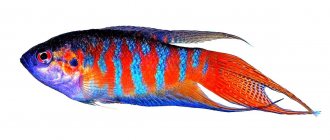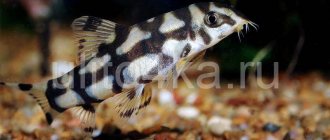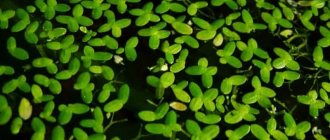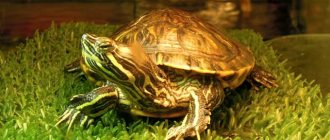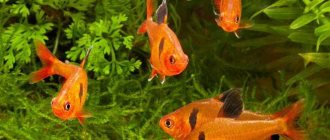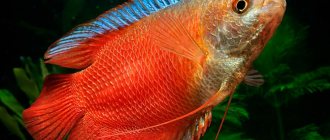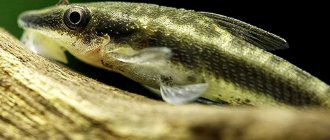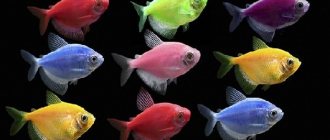Almost no community aquarium is complete without livebearers. Why are these fish so popular?
First of all, let us explain where the name “viviparous” came from. Fertilization of the female occurs in the genital tract, and the eggs develop there, unlike most other fish. After about a month, already formed fry are born - mini copies of their parents, capable of swimming and feeding independently. Reproduction of these fish in a home aquarium does not present any difficulties! Of course, for the safety of the offspring, thickets of shelter plants are necessary while the fry are tender and vulnerable. Or you can use special spawning aquariums.
Viviparous fish are quite unpretentious to their living conditions. For small representatives, volumes from 10 liters are suitable, for larger species – from 50-60 liters. But, naturally, in large (150-300 liters) aquariums the fish feel more comfortable! Livebearers live well in a school or “harem”, but you shouldn’t have one fish at a time – they will stress you out. They are peaceful and friendly and look great in planted aquariums!
We have selected the most common and favorite viviparous fish among aquarists and are eager to introduce you to them.
Guppy (Poecilia reticulata)
Guppy is perhaps one of the most famous aquarium fish! The homeland of these fish is the reservoirs of America. Nowadays, guppies are found in nature on different continents. Male guppies are very different from females: they have all sorts of bright colors and luxurious tails! Selection has produced red, yellow, green, black, blue, orange, neon solid colors, as well as mixed colors. Female guppies are more modestly colored and have more compact tails; they are larger than males. Guppies are unpretentious and are suitable for both professionals and beginners. These fish grow up to 4-6 cm and live for about 2 years.
Maintenance and care
In most cases, viviparous fish are schooling. It is necessary to provide spacious conditions for them, calculating 2-5 liters per adult. The presence of dense vegetation is required so that the female can sometimes hide from suitors. For the beauty of the underwater world, it doesn’t hurt to get high-quality lighting.
In nature, animals live in stagnant bodies of water or with very weak currents. Therefore, it is recommended to provide aeration and filtration for pets. Be sure to make sure that the filter does not interfere with the fry.
Gambusia fish
The optimal water temperature for viviparous aquarium fish is 20-28 degrees Celsius. To provide the animals with warm water, you will have to get a heater with automatic start.
As for feeding, the diet must include vegetation. For proper growth and development, you need a balanced diet consisting of all types of food. It is useful to add scalded vegetables. Grown-up individuals are fed once a day, while young animals require increased nutrition, at least 5 times.
Otherwise, these fish are very hardy. The main thing is to populate the optimal number of males and females (1 male + several females) to eliminate rivalry and fights. Water changes are carried out once a week, a quarter of the volume is replaced. However, if the owner leaves or for some other reason cannot take care of it, the fish tolerate old water just fine.
Black-tailed swordtail (Xiphophorus hellerii var.)
The black-tailed swordtail is a “classic” of aquarium hobby! In nature, swordtails live in water bodies of America. They have an elongated, slightly laterally flattened body with a pointed head. In males, the caudal fin has a sword-shaped outgrowth, hence the name of the fish. Also, in males, the anal fin has the shape of a “tube” - another difference from females. The body of the black-tailed swordtail is painted bright red, the fins are black. Swordtails look luxurious against the greenery of the aquarium! They can live either in pairs or in flocks. Black-tailed swordtails grow about 10-12 cm and live for about 2-3 years.
Popular types
The most famous representatives of the aquatic environment are viviparous aquarium fish. Their list is compiled based on the preferences of the owner and the available conditions of detention.
In most cases, the following inhabitants are populated :
- guppy;
- mollies;
- platies;
- swordtails.
All these species are easy to care for, reproduce quickly and have an attractive appearance.
Multicolored guppies
The homeland of this representative of aquatic fauna is considered to be the territory of South America. There they live in all fresh water bodies and easily adapt to the characteristics of each of them.
Guppy fish have an attractive appearance and are easy to breed.
Distinctive features of the type and content requirements:
- The adult size ranges from 4.5 to 5.5 cm.
- The male has a brighter coloring, which makes them stand out among the females.
- It is best to house a small group of 2 pairs of individuals.
- They require at least 50 liters of water.
- Guppies are not very picky about water hardness, but prefer temperatures between 25-27 degrees.
- They are unpretentious in food and will happily eat dry, plant, and animal food.
- A guppy aquarium should have plenty of vegetation and free space for swimming.
These aquarium inhabitants have a peaceful nature, so they can easily get along with other species. Guppies reproduce very quickly. After a few weeks, the fry reach the size of their parents and also begin to breed offspring. In order to take control of this process, you can place male and female individuals in different aquariums.
The viviparous platy fish reaches 6 cm in length
Little platy
In the wild, this fish lives in small streams and rivers in Mexico. There it adapted well to environmental conditions and multiplied quickly. This small fish can reach 6 cm in length. Male individuals are more mobile, narrow-bodied and brightly colored.
Necessary conditions of detention:
- Platies need to be housed in a flock of 6-9 individuals. In this case, there should be half as many males as females.
- For such a number of inhabitants, a tank with a volume of 80 liters will be sufficient.
- Ideal temperature conditions are considered to be 22−26 degrees.
- You can feed your platies with both live and dry food.
- For a comfortable life, fish need a lot of vegetation in the aquarium.
This species gets along well with other small fish and does not pay any attention to their presence. For breeding, the female is placed in a separate aquarium with dense vegetation. After a few days, she gives birth to up to 100 cubs, which grow quickly and reach sexual maturity at the age of 4 months.
Graceful mollies
This species is widespread throughout Central America. There they live in the coastal waters of rivers or small lakes.
Adults rarely grow more than 8 cm in length and prefer to lead a peaceful lifestyle. Because of this, mollies are often housed with other viviparous representatives.
Features of care:
- It is best to keep 5 females and 3 males in an aquarium.
- Fish need at least 100 liters of water to live comfortably and reproduce quickly.
- These representatives of the fauna love salt, so it can be added in a proportion of 20 g for every 10 liters of water.
- The ideal temperature for them will be from 24 to 26 degrees.
- They eat dry and live food with pleasure. It is recommended to add plenty of plant foods to your daily diet.
At one time, a female molynesia can hatch up to 150 young.
At one time, a female can hatch up to 150 young. At the same time, there is no need to place it in a separate tank. The fry are also not picky eaters and can grow quickly on almost any small food.
Hawaiian flag platie (Xiphophorus variatus)
Hawaiian flag platie is a bright, peaceful and harmless, completely unpretentious fish! Found naturally in American waters. This type of platies was bred through selection. The body shape is elongated, slightly compressed laterally, the head is pointed, with large eyes. The color of the body and fins includes yellow, red, orange and black. The dorsal fin is high and develops in the form of a flag. Males and females can be distinguished by the size and shape of the anal fin: males are smaller, the anal fin has the shape of a “tube”. Pecilia can be safely recommended to beginners. They grow about 5-6 cm and live about 2 years.
Reproduction
The distinctive features of viviparous species are that they reproduce easily in an aquarium and have high fertility.
Puberty of fish occurs at 4 months after birth.
The female develops eggs in her abdomen, and the male fertilizes them with seminal fluid using the gonopodium. During pregnancy, the abdomen becomes rounded, and as birth approaches, a dark spot appears near the anal fin. The eggs hatch after a month and a half and are born. After 1 fertilization by a male, a female is capable of giving birth 3–4 more times. At one time, a female can give birth to up to 170 fry.
After birth, the fry float to the surface of the water, expand their swim bladder with air and are already able to live independently. They begin to feed on the second day of life.
For a comfortable stay, you will need plants in which the fry can hide after birth, for example, riccia. Adult fish and fry are kept in separate tanks because fish often eat their young. When kept together, the inhabitants are provided with a sufficient amount of food, then the fry will survive.
Differences between female and male
Female and male livebearers are easily distinguishable from each other. In almost all species, females are larger and more massive, and males are small and graceful. Females are endowed with a discreet and grayish color, while males are bright, with long fins of different shapes.
But the main difference will be the shape of the anal fin: in mature males it lengthens and turns into an organ for fertilizing eggs inside the female - gonopodium. In females, the anal fin has a rounded shape and small size.
Black molly (Poecilia latipinna var.)
Black mollies or black molly is a fish that has long been loved by aquarists! Initially, mollies lived in the waters of America. Selection has produced many color forms of these fish, including the black molly. The fish has an elongated, slightly laterally compressed body, painted velvety black. Females are larger than males, pot-bellied, and do not have an anal fin - a “tube”. Black molly has gained its popularity due to its unpretentiousness, vitality, good disposition and beauty. In the absence of plant components in the food, they may pinch the leaves of delicate herbs (pinnate, cabomba). Mollies grow up to 10-12 cm and live for about 3 years.
Venezuela forked guppy (Poecilia wingei)
The forked guppy “Venezuela” is a relatively “young” fish in the aquarium hobby. The homeland of this species is the reservoirs of South America. The fish that are currently on sale are selective forms of the forked guppy. What distinguishes these fish from “classic” guppies is their miniature size (about 3 cm) and coloring: forked guppies are painted in neon colors, with spots located on the body, the caudal fin is not completely colored, but along the contour, in the form of a forked “fork.” The females of these guppies are also larger than the males and have a uniform silver color. Forked guppies are perfect for nano aquariums due to their size and friendly disposition. They live in an aquarium for about 2 years.
Gambusia are the most unpretentious inhabitants of the aquarium
These creatures do not have the most spectacular appearance. Despite the fact that all types of viviparous aquarium fish are very easy to care for, mosquito fish are the leaders in this matter. They can live in absolutely any temperature. They normally tolerate low levels of oxygen in it, as well as any contaminants. Of course, you can’t torture your fish by neglecting to change the water or subjecting it to constant temperature changes. It is recommended to take her as the first underwater inhabitant. Unfortunately, mosquito fish are rarely found in pet stores.
They do not need a large aquarium volume. 50 liters of water will be enough for one flock. Of course, the larger the aquarium, the more comfortable the creatures will be in it.
Swallowtail molly (Poecilia velifera)
Velifera sailing molly is a luxurious, rather large fish native to the reservoirs of South America. She has a classic, elongated, slightly laterally flattened body with a graceful sail-shaped dorsal fin. Various color variations of this fish have been selectively bred. The most common of them are: orange, white, black, marsh. Velifera cannot help but attract the eye while swimming in the aquarium. Males are especially good when courting a female or sorting things out with each other! These fish grow about 15 cm and live for about 3-4 years. They are unpretentious and suitable for a beginner aquarist.
Red swordtail (Xiphophorus hellerii var.)
The red swordtail is another fish that has captured the hearts of aquarists for quite some time. These fish are native to the waters of Central America. The “classic” red swordtail is a bright and peaceful inhabitant of the home aquarium. Males are distinguished from females by the presence of a “sword” outgrowth on the caudal fin, which can be equal in size to the length of the body. As the name suggests, this swordtail is painted entirely red and the sword has a black edge. Like most “colored” swordtails, this species was also bred through selective breeding. Swordtails are unpretentious and are perfect for a novice fish farmer. They grow about 10 cm and live in captivity for about 3 years.
Mickey Mouse platy (Xiphophorus maculatus var.)
Pecilia Mickey Mouse is a relatively new breeding form of platie that has forever won the sympathy of aquarists. In nature, it lives in water bodies of America. The fish got its name for its coloring: at the base of the caudal fin it has a mark in the form of a head with ears of the cartoon character Mickey Mouse. Body color is orange-yellow. These fish are especially popular in “children’s” aquariums! In addition, its compact size allows you to launch Mickey Mouse from the smallest containers (from 10 liters) - another plus of this cute fish. Platies grow about 5 cm and live for about 2 years.
Silver molly, snowflake (Poecilia sphenops var.)
Silver mollies are quite large, growing up to 14 cm, a selective form of mollies. In nature, the fish lives in the waters of Central and South America. They got their name for their velvety, white-silver color. Snowflakes have an elongated, strong body, slightly compressed from the sides, and a pointed head. The dorsal fin of males is larger than that of females. These fish are friendly and perfect for a community aquarium. It is interesting to observe the behavior of snowflake mollies: males engage in fights for females, circling, pinching each other, and spreading their fins. At home, these fish live for about 3 years.
Balloon mollies (Poecilia sphenops var.)
Balloon mollies are the fruit of breeding work and are not found in natural conditions. This interesting fish has a decorative barrel-shaped body, which gives it a clumsy and at the same time unforgettable appearance! The colors of the cylinders are varied: white, black, orange, green and others. Balloon mollies grow smaller than their original forms, so they are great for small (from 30 liters) aquariums. These fish are also unpretentious and friendly, and can be recommended to both professionals and beginners. They grow up to 5-6 cm and live in an aquarium for several years. Mollies pass on their barrel-shaped body shape to their offspring.
© Aqua Logo Evgeniya Stepanova
Fields marked with * are required.
Conditions of detention
Breeding aquarium fish is a rather complicated process that requires a significant investment of time and money.
Viviparous fish are considered popular creatures among aquarists.
Their list is limited to only three families:
- Gudeevs. There are 16 genera and 35 species of aquarium inhabitants.
- Four-eyed fish. Among lovers of aquatic pets, only 4 species are known.
- Poeciliaceae. These are the most common creatures that easily take root and quickly breed offspring.
In the wild, these fish live in fresh water bodies throughout South and Central America. Sometimes such representatives of aquatic fauna are found in the southern United States and Asia.
Under natural conditions, viviparous fish live in fresh water bodies
equipment requirements
As a rule, all viviparous fish for an aquarium prefer to lead a schooling lifestyle. Because of this feature, they should be housed in large-volume tanks.
At least one and a half liters of water should be provided for each individual. The higher this indicator, the more comfortable your pet will feel.
It is forbidden to use small aquariums, as its inhabitants will suffer from lack of space, which can lead to conflicts or death.
The tank should be well lit, since viviparous fish feel more comfortable in the light. In this case, it is necessary to try to recreate their natural living conditions and turn off some of the lighting fixtures at night.
In the aquarium it is necessary to place various driftwood, stones and plant living plants . With their help, the fish will be able to hide and take a break from everyday worries.
It is important to provide viviparous fish with light.
Large individuals require a lot of personal space, so they should only be kept in containers of the appropriate size. Otherwise, males may begin to fight for territory and greatly harm each other.
In the wild, these representatives of the fauna live in stagnant or slow-flowing water, so it is best to create similar conditions in the aquarium and provide its inhabitants with a slow flow. If everything is done correctly, you can significantly speed up growth and reproduction. With good aeration, the fish are maximally protected from various health problems.
Most viviparous aquarium fish feel comfortable at temperatures from 20 to 29 degrees. To maintain it, you need to use special aquarium heaters , the power of which is selected based on the volume of the tank.
It is very important to ensure constant water filtration. This will protect the aquarium from contamination and make it easier for owners to clean it.
https://youtube.com/watch?v=kZRqzz9fsus
Features of care
Almost all viviparous aquarium fish that can live at home do not require special care.
They have strong immunity and are able to survive even in the most extreme conditions.
These include:
- rapid decrease or increase in water temperature;
- decreased oxygen levels;
- poor lighting;
- insufficient aeration;
- increasing water hardness.
However, even the strongest individuals may not be able to withstand a long absence of comfortable conditions. You need to constantly monitor the situation and, if necessary, take immediate action to correct problems.
Viviparous fish have good immunity, but you should not abuse the lack of care
When introducing fish into an aquarium, it is necessary to take into account the fact that for each male there should be 2-3 females . This will eliminate the possibility of conflicts during the breeding season. In addition, when combining several types in one tank, you need to take into account the characteristics of each. It is important to make neighbors only peace-loving fish that cannot harm each other.
To maintain optimal water parameters, you need to periodically replace a third of the total volume. It is best to do this every week to eliminate the possibility of problems with your pets.
Daily diet
The basis for the health of all species of viviparous fish is proper and varied nutrition. Thanks to it, aquatic inhabitants receive everything they need for rapid growth and reproduction.
When choosing food, you should pay attention to its freshness and expiration date. In addition, you should avoid foods with a lot of dyes. It is strictly forbidden to use low-quality food, as there is a possibility of harming the health of pets.
Food for viviparous fish must be fresh
Almost all livebearers are unpretentious eaters. They are able to eat almost any type of food, but it is best to give them the following treats :
- Specialized food for tropical fish. It is available in flake form and can be used in daily feeding. You can buy it at any pet store at an affordable price.
- Live food. Tubifex, bloodworms and brine shrimp can be used as such food. The fish will not refuse chopped squid.
- Plant food. It is best to give your pets seaweed, spinach and parsley. Any type of greenery must first be scalded with boiling water and finely chopped.
- Groats. Heavily boiled semolina or rolled oats can be a good food.
Daphnia can be added to the diet of viviparous fish
In addition, you need to pamper viviparous fish with another type of food at least once every few weeks. This will help avoid addiction to the diet and add essential vitamins to representatives of aquatic fauna. Additives can include :
- Daphnia;
- small worms;
- shrimps;
- boiled chicken;
- beef liver and heart;
- lettuce leaves;
- peas.
All food must be ground to suitable sizes. This way the fish can easily swallow every piece of it.
Reproduction process
All viviparous fish are distinguished by their fertility. In a short period, each female is capable of producing up to 200 fry, which quickly develop and turn into adults.
For reproduction, it is extremely important to place several females and one male in the aquarium at once. The sex of an individual can be determined by the following characteristics :
- Females are much larger than males in size.
- In males, the caudal and dorsal fins are more refined.
- Males have bright colors and attractive appearance.
As soon as the female has eggs, the male immediately fertilizes it. Over the next 30−50 days, the female bears the young. As soon as the fry are ready for independent life, they leave the mother's body. As a rule, cubs are born at different times and the whole process can last for several weeks, or even months.
In a short period of time, a female viviparous fish can hatch up to 200 fry
Once born, fish reach sexual maturity within 4 months and can also produce offspring.
In order for the fry to develop properly and grow quickly, they need adequate nutrition . To do this, you need to add various vitamins to your daily diet. The parents also need to be well fed during this period, since if there is a lack of food, they will happily feast on their cubs.


